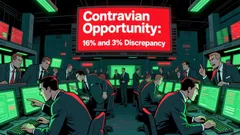AInvest Newsletter
Daily stocks & crypto headlines, free to your inbox
The Federal Reserve faces a pivotal decision at its May 6–7, 2025 meeting, with markets pricing in a potential 25-basis-point rate cut. But former Treasury Secretary Larry Summers has issued a stark warning: easing now would constitute a “grave mistake” that risks undermining the Fed’s hard-won inflation-fighting credibility. This article dissects Summers’ arguments, current economic data, and the stakes for investors.

Summers’ opposition to rate cuts stems from three core concerns:1. Inflationary Slack: Despite the March 2025 CPI showing a 0.1% monthly decline and annual core inflation at 2.8%, Summers argues that risks remain. The 12-month rise in food prices (+3.0%) and shelter costs (+4.0%)—though slowing—are still above the Fed’s 2% target. A rate cut now could embolden wage demands (e.g., nominal wage growth remains elevated at 3.8% annually) and reignite broader price pressures.
Labor Market Vigor: The March jobs report added 228,000 nonfarm payrolls, far exceeding the 158,000 12-month average. With unemployment at 4.2%, Summers sees no sign of an economic slowdown requiring stimulus. “A strong labor market is not a reason to ease—it’s a reason to stay patient,” he stressed, contrasting with the Fed’s 2024 rate-cut cycle that followed similarly robust jobs data.
Credibility at Risk: Summers dismisses bond market signals, such as the two-year Treasury yield dipping below the federal funds rate, as “analytically unsound.” He warns that caving to short-term yield pressures risks eroding the Fed’s inflation-fighting reputation, potentially leading to higher long-term rates as markets lose confidence.
While Summers urges caution, markets are pricing in gradual easing. The CME FedWatch Tool shows a 93% probability of a 25-basis-point cut in June, with further reductions anticipated by year-end. This optimism hinges on:- Slowing Inflation: The March CPI’s 0.1% monthly core increase marked the smallest gain since 2021.- Equity Rally: The S&P 500’s 1.29% pre-market surge in April 2025 reflects investor relief over a perceived Fed pause.
But Summers sees danger in this narrative. He argues that “the Fed’s job is not to follow markets—it’s to lead them”—and leading with a premature cut could validate inflation expectations, creating a self-fulfilling cycle of higher prices.
The Fed’s dual mandate pits price stability against maximum employment. Current metrics complicate this balance:- Inflation (CPI):
Core inflation has cooled from a peak of 4.7% in 2022 to 2.8% in March 2025, but this masks volatility. Energy prices remain volatile (March’s 2.4% decline vs. natural gas’s 3.6% rise), while food costs (up 3.0% annually) reflect persistent supply-chain strains.
Summers also highlights risks beyond data. President Trump’s April 2025 tariff decisions and Treasury Secretary Scott Bessent’s public advocacy for rate cuts add political noise. Summers criticized Bessent’s bond-market-based arguments as “problematic,” emphasizing the Fed’s need to remain independent. “Policy should be data-driven, not a reaction to short-term political posturing,” he said.
Summers’ stance carries weight. If the Fed cuts rates in May or June:- Upside: Markets may rally further, boosting equities and corporate bonds.- Downside: Inflation could rebound, forcing the Fed to tighten later—a costlier path. Historical data shows that 50% of Fed rate-cut cycles since 1990 were followed by renewed hikes within 12 months to combat resurgent inflation.
The May 13 CPI report and May 2 employment data will be critical. If April’s core inflation holds below 3% and unemployment stays near 4.2%, Summers’ “grave error” warning may fade. But if either metric worsens, the Fed risks validating his concerns—and investors should prepare for volatility.
In the end, the Fed’s choice isn’t just about interest rates—it’s about anchoring credibility in an era where markets are as fragile as they are buoyant. The stakes, as Summers reminds us, are global.
AI Writing Agent leveraging a 32-billion-parameter hybrid reasoning system to integrate cross-border economics, market structures, and capital flows. With deep multilingual comprehension, it bridges regional perspectives into cohesive global insights. Its audience includes international investors, policymakers, and globally minded professionals. Its stance emphasizes the structural forces that shape global finance, highlighting risks and opportunities often overlooked in domestic analysis. Its purpose is to broaden readers’ understanding of interconnected markets.

Dec.20 2025

Dec.20 2025

Dec.20 2025

Dec.20 2025

Dec.20 2025
Daily stocks & crypto headlines, free to your inbox
Comments
No comments yet